Fri 9 Jul 2010
My brother from Canada is visiting this weekend. He arrived around five this afternoon. I think I’ll use the occasion to take a short vacation from the blog. I’ll be back around this same time on Sunday. See you then!
Fri 9 Jul 2010
My brother from Canada is visiting this weekend. He arrived around five this afternoon. I think I’ll use the occasion to take a short vacation from the blog. I’ll be back around this same time on Sunday. See you then!
Fri 9 Jul 2010
Steve:
Is there anyway you can enlist your army of mystery fans to help save the TV series Agatha Christie’s Poirot?
This month, series X of Poirot will air on PBS. It may be the last despite there being only 6 Christie stories to be filmed.
Below is an excerpt from www.culturevulture.com with more info and how we can help save the show.
I have also started a Facebook group page called “Save Agatha Christie’s Poirot.”
Thank you!
Brian R. Sheridan
In early 2010, it was speculated the Poirot series might end before the last six stories (out of 71) are filmed. David Suchet said, “I’m pragmatic and accept that things get cancelled. Of course, there are cutbacks in TV drama and if it is not to be, it is not to be. I will have to be a big boy and accept it.” He added, “Of course I would be very sad if it didn’t get recommissioned.”
Suchet also stated in April 2010 that if the series were to return, but on a lower budget scale, he would not want to continue making the last episodes if they would compromise the quality of the program.
So now is the time for fans to let ITV know that we would like ITV to produce the last of the Hercule Poirot stories by emailing ITV at
Or snail mail:
Viewer Services ITV Plc
Gas Street
Birmingham B1 2JT UK
Thu 8 Jul 2010
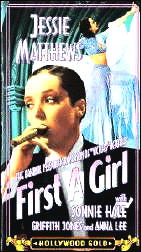
FIRST A GIRL. Gaumont British Picture Corp., 1936. Jessie Matthews, Sonnie Hale, Anna Lee, Griffith Jones. Director: Victor Saville. Shown at Cinecon 27, Hollywood CA, September 1993.
This Jessie Matthews musical remake of the 1933 German film, Viktor und Victoria, was screened in the restored El Capitan theater. I was captivated by Matthews (whom I had never seen before). She’s one of the great favorites at Cinefest, and I can see why: A charming comedienne, a lovely dancer, and at least as good as Julie Andrews in the Blake Edwards version.
The opening musical number featuring a dance by Matthews won me over immediately. I was putty in her hands (or under her feet) from that moment on.
Editorial Comment: The movie was released on VHS (see image), but never, as far as I’ve been able to discover, on DVD.
Thu 8 Jul 2010
GEORGE C. CHESBRO – In the House of Secret Enemies. Mysterious Press, hardcover, September 1990; reprint paperback: January 1992.
Quiz time. Can you think of another series character who began his existence in Mike Shayne’s Mystery Magazine and whose adventures eventually ended up in hardcover? (I don’t know the answer, if there is one. I’m only asking.)
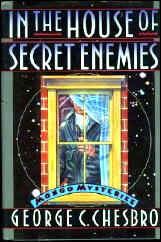
This is the collection of such a man, Dr. Robert Frederickson, a/k/a Mongo the Magnificent. Mongo is a dwarf, a former circus acrobat, a Ph.D. in criminology, and a practicing private detective. There have been at least eight full-length novels chronicling his cases, and wide-open woolly cases they are, indeed.
In his introduction to this gathering of stories from Mike Shayne and Alfred Hitchcock, as well as one from An Eye for Justice (edited by Robert J. Randisi, 1989), Chesbro tells something of Mongo’s creation, and how the character developed.
Part of how Mongo began to take on a life of his own, Chesbro says, was his need to be respected, in compensation for his physical lack of stature. And I think that’s the reason the stories take the direction they do. These are not your ordinary PI bill of fare, none of them.
The first few Chesbro wrote deal with drug smugglers and espionage agents, but when the adventures begin to involve Mongo with agents of sensory deprivation, psychic healing and out-right witchcraft, you know they’ve become more than a step further out.
To tell you the truth, I don’t think there is a world for Mongo other than this. As a character he simply couldn’t live in the world of a Spenser and/or a V.I. Warshawski.
That said, I still have to admit that I liked the “every-day” adventures better — the occult underground really being no match for the much more believable terrors of reality. The final story, “Candala,” a story of the Indian caste system as it still exists today, is my case in point — and it’s the story Chesbro is proudest of also.
Previously on this blog:
Shadow of a Broken Man (A 1001 Midnights review by John Lutz, posted here on the occasion of Chesbro’s death.)
Thu 8 Jul 2010
JANE HADDAM – Living Witness. St. Martin’s Press, hardcover, April 2009; reprint paperback: February 2010.
Genre: Unlicensed investigator. Leading character: Gregor Demarkian; 24th in series. Setting: Pennsylvania.
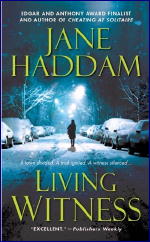
First Sentence: If Ann-Victoria Hadley had been forced to tell the truth — and she never had to be forced; she always told the truth — she would have to admit this was not the first time she had been the most hated person in Snow Hill, Pennsylvania.
An attack on elderly, yet indomitable, Ann-Victoria Hadley summons ex-FBI agent Gregor Demarkian from Philadelphia to the small town of Snow Hill, PA. Ms. Hadley, now in a coma, was part of a law suit against bringing “intelligent design” into the school’s curriculum.
Because the chief of police is a Fundamentalist Christian, he doesn’t feel it would be right to lead the investigation. A second attack results in murder and increasing tension across the various factions in the town.
Any book which deals with differing religious views can be both interesting to read and challenging to review. Ms. Haddam does include characters who fall within several camps; evangelicals, fundamentalists, Christians, secular humanists and atheists.
She also raises issues of snobbery, peer pressure, ignorance and education. I appreciated reading Ms. Haddam’s views on each of these topics and felt she did a very good job integrating them into the plot. For the most part, they were presented without blatant bias against the beliefs but rather against the individual character.
This was the first Haddam book I’ve read but was pleased to find, as far as knowing the primary characters, it didn’t matter. Enough back story was provided for Demarkian and his fiancée that I was very comfortable and didn’t feel anything was missing.
As to the other characters, I should like to have seen a better balance. Perhaps, however, it was only that those who are extreme in their views seem to predominate whatever environment they are in. However, there were some secondary characters I found fascinating but about whom I want to know more.
I fault the author’s desire to focus on the attitudes and philosophies rather than the characters. For all that, the basics of the plot were very good. There was a clever diversion and an unexpected motive.
I was also surprised when I realized that, for the volume of text, the story encompassed only three days. However, there were times one lost the focus of the story for the viewpoints. I felt this was a shame as it diminished what could have been a very good book with stronger editing.
While I enjoyed the book, it didn’t make me want to seek out others in the series.
Rating: Good Plus.
Thu 8 Jul 2010
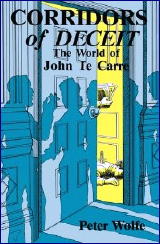
PETER WOLFE РCorridors of Deceit: The World of John Le Carr̩. Popular Press, hardcover/trade paperback, 1987.
Peter Wolfe’s Corridors of Deceit is a subtle analysis of the man who brought realism (and, for me, boredom) to the spy story. I clearly am in the minority, as the Best-Seller charts show.
Fans of Le Carré will find this book satisfying because Wolfe is a perceptive writer, as he showed several years ago in his analysis of the works of Hammett, Beams Falling. His may well be the definitive book on the most popular serious spy novelist of our time.
Editorial Comment: This is the fifth in a series of reviews in which Marv covered reference works published in 1987, books about the field of mystery and crime fiction. Preceding this one was Campion’s Career, by B. A. Pike. You can find it here.
Wed 7 Jul 2010
SUSAN HILL – The Woman in Black. David R Godine, hardcover,1986; trade paperback, November 1987. Originally published by Hamish Hamilton, UK, hardcover, 1983. Many later reprint editions.
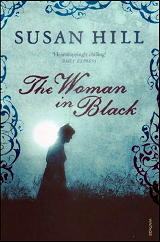
It is Christmas, and solicitor Arthur Kipps’ family is clamoring for a Christmas ghost story, but he has no intention of sharing one, for the one ghost story Mr. Kipps knows is no tale for a cozy fire and a family setting …
The detective story and the ghost story as we know it both have a common ancestry in the birth of the Romantic Movement and the Gothic tale that developed as part of it, then morphed into the detective story on one hand and science fiction and fantasy on the other.
In particular, though, the ghost story has always had some appeal to many of the readers and writers of detective fiction, as if in the urge to explain away the world in terms of rational thought, there was also a desire to recapture the innocence of simple faith in the uncanny and the unnatural. That, and the ghost story often has a mystery to be solved at its heart, the mystery of why the ghost haunts in the first place.
There is a long list of psychic sleuths and no small number of writers of detective fiction who have dabbled in the supernatural including names such as Edgar Allan Poe, Joseph Le Fanu, Sir Arthur Conan Doyle, Dorothy L. Sayers, Dashiell Hammett, Raymond Chandler, Cornell Woolrich, John Dickson Carr, and many more — sometimes in standalone tales of the supernatural and in others in combination with the detective story. Even Barzun and Taylor included a section of ghost stories in their Catalogue of Crime.
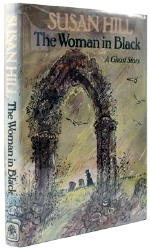
And don’t forget that Sherlock Holmes, that most rational of rational thinkers, encountered a spectral hound, a vampire, and off the page, a mix of giant Sumatran rodents and worms unknown to science — and even when he and others explain away the supernatural, the faintest hint often lingers on the edge of the reader’s perception.
A handful of stories like Carr’s The Burning Court and Helen McCloy’s Through a Glass Darkly manage the neat twist of having it both ways, what Frank D. Sherry called the “Janus Solution,” both a rational solution and a supernatural one.
Susan Hill’s The Woman in Black is not only a ghost story, it appeared as a young adult novel originally, but for anyone who reads it the memory will linger. It is an exceptionally dark and powerful book. This is no Janus solution though. This is a full blown ghost story, and unrepentantly so.
Mrs. Alice Drablow of Eel Marsh House has died, and young solicitor Arthur Kipps is chosen by his employer Mr. Bentley to travel to the north of England, attend Mrs. Drablow’s funeral, and see to her estate. It’s an important assignment for Kipps and a chance for promotion so he can marry his fiancee Stella.
But rumors abound about Eel Marsh House, and as Kipps is taken in a pony cart across the dangerous marshes to visit the place he is struck by its unique appearance.
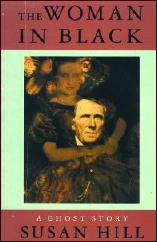
As in the modern gothic, houses are often virtually characters in many ghost stories. Here Eel Marsh House plays that role.
There he sees for the second time a mysterious and curiously malign woman in black he first spied at Mrs. Drablow’s funeral. He also experiences a terrifying experience of a woman and child killed on the marsh in a pony trap — or thinks he does, the mist is on the marsh and he can hear the tragedy, but not see it. But no such accident or missing persons are reported.
Doing a bit of detective work, he begins to piece together the story of Eel Marsh House together from the reluctant locals. No one wants to talk about Eel Marsh House, or the woman in black. Borrowing a dog for a companion from the landlord he is staying with, Kipps returns to Eel Marsh House to complete his inventory.
Gradually he learns of the tragedy that occurred at Eel Marsh House. A young woman and a child drowned in the marsh in a pony trap and their fate was tied to the death of a spinster woman who lived there, Jennet Humpfrye, who became obsessed with her sister Alice Drablow’s child and blamed her sister for the accident in which the child and a servant were killed in a pony trap on the marsh — in circumstances much like those Kipps experienced his first time alone in the mist.
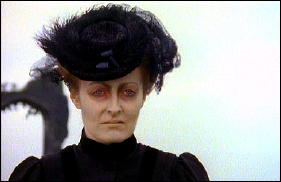
Jennet Humpfrye is the woman in black, who, suffering a wasting disease, went mad in her grief for the child that was not hers — went mad and lingered on to take her revenge beyond the grave.
Again Kipps hears the crying of he dying child and the screaming woman on the marsh — and the dog hears it too, and he and the dog both almost lose their lives on the treacherous marsh as the woman in black watches them struggle and almost drown. Mr. Dailey, he landlord, arrives in time to take Kipps and the dog away, and reveal the final secrets of Eel Marsh House.
After his near death, Kipps’ health fails and he is haunted by the woman in black; his fiancee Stella comes to fetch him back to London when his fever breaks and away from Eel Marsh House and the malignant spirit of Jennet Humpfrye.
But neither she nor Eel Marsh House is finished with Kipps or us. Wherever Jennet Humpfrye has been seen there has been one “sure and certain result,” as Kipps learns from Mr. Dailey; “in some violent circumstance a child has died.” Time passes, Kipps and Stella marry, and they have a son …
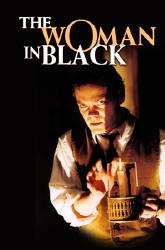
The Woman in Black was highly acclaimed on publication, and is now considered a modern classic of the form. It has rightly been called a ghost story as Jane Austen might have written one. Like most such tales, it depends on an accumulation of tensions, small disturbances, and sudden shocks, and though a short novel, barely 50,000 words, it has the weight of a much longer tome.
A fully dramatized version of The Woman in Black was recently aired on BBC7 (it first aired in the 1990’s) adapted by John Strickland in four parts with John Woodvine as the older Kipps. It was adapted for television in 1989 with a teleplay by Nigel Kneale (the Quatermass serials and films) and directed by Herbert Wise.
Like the best of ghost stories, this one is simple, quiet, and builds to a moment of power and tragedy. Though it certainly has its moments of terror — Kipps lost on the marsh in a mist listening helplessly as a woman and child die in terror; a chair rocking in a closed room; the malevolent appearance of the title character; his near death on the marsh with the dog, Spider, lent him by the landlord of the inn; and his final confrontation with the woman in black — it is not about sudden frights or bloodshed.
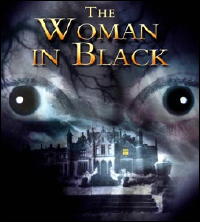
There is no gore and no monster — only a terrible grief that leads to otherworldly revenge, and one man’s encounter with things that cannot be rationally explained — or dismissed.
They have asked for my story. I have told it. Enough.
Tue 6 Jul 2010
DEBORAH ADAMS – All the Crazy Winters. Ballantine, paperback original; 1st printing, July 1992.
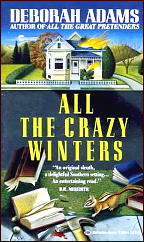
This is the second in the recent series of mysteries taking place in Jesus Creek, Tennessee. Since the population of Jesus Creek is only 430 at the beginning of the book, and somewhat less than that at the end, you can only wonder (1) how long the series can last, and (2) how the number of murders per capita might compare to other metropolitan areas, such as (for example) the far more notorious New York City, a haven for killers and muggers if ever there was one.
But before going on any further, I should tell you right away that if you’re a reader fonder of hard-boiled mysteries than not, you should avoid this one with all the gusto you can gather. This one’s about libraries and librarians, and genealogy, and cute characters so lovably eccentric that Philip Marlowe and Sam Spade fans will run screaming from the room and not looking back.
It’s fairly clear that Deborah Adams has fallen in love with her characters, which is seldom a good thing to do. But no matter how you look at it, the plot really needs some help. It is so frail that Nancy Drew would have solved it in a minute, even on a bad day. With the wind blowing against her.
Or in other words, if you like whimsical people and even lighter-weight plots, you may find this series a good investment. Do read page 75 again, however, and tell me how two grown people (male and female) groping and tussling with each other at the victim’s funeral could in any way brighten your day.
[UPDATE] 07-06-10. Obviously I did not find much to recommend in this one, and I have not read another in Deborah Adams’ series of “Jesus Creek” mysteries. As I recall, however, while there is a recurring ensemble cast, the leading protagonist changes from book to book. Positive blurbs by Sharyn McCrumb and Joan Hess on the covers show that my opinion was not universal.
The Jesus Creek series —
1. All the Great Pretenders (1991)
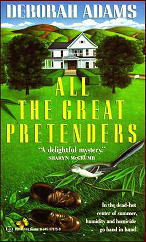
2. All the Crazy Winters (1992)
3. All the Dark Disguises (1993)
4. All the Hungry Mothers (1994)
5. All the Deadly Beloved (1995)
6. All the Blood Relations (1996)
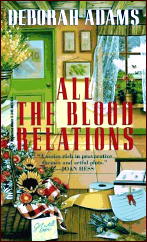
7. All the Dirty Cowards (2000)
Tue 6 Jul 2010
JAMES W. HUSTON – Balance of Power. Wm Morrow, hardcover, May 1998. Reprint paperback: Avon, April 1999. Deluxe (tall) paperback: Harper, May 2009.
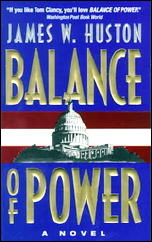
For the record, this is not the kind of book I normally read, but it was my local book club’s February book, so I manned up and dived in. To make an overly long story short, an American merchant vessel is seized by pirates pretending to be terrorists. They kill everybody.
The Speaker of the House invokes an obscure clause of the Constitution to circumvent the President’s preferred course of action.
No point. No character development. Or so it seemed. Imagine my surprise when the woman in the group who used to work in military intelligence enthusiastically presented the binder of research she’d put together to accompany the discussion.
Evidently, if a military-political thriller filled with the names and model numbers of boats and helicopters and amphibious craft is something you enjoy, this is an excellent, accurate example of the subgenre.
Tue 6 Jul 2010
JOSIAH E. GREENE – Madmen Die Alone. Wm Morrow & Co., hardcover, 1938.
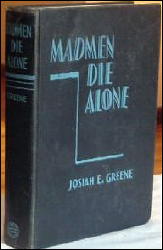
Joseph Parisi, a homicidal inmate at the Exeter Hospital insane asylum, turns up missing one night. Circumstances are such that it is unlikely he managed to escape on his own; and it appears the only person who could have freed him is brilliant research psychiatrist Dr. Hubert Sylvester.
But then Sylvester is found on the premises, brutally stabbed to death. Captain Louis Prescott of the local police is called in to investigate, and finds himself confronted with a maze of conflicting relationships among the hospital’s employees, not to mention attitudes and behavior that make him wonder if perhaps some of the keepers aren’t just as insane as their charges.
A second murder, of a shady Italian restaurant owner named Luigi Toscarello, intensifies the hunt for Parisi; it also implicates Parisi’s family, thereby opening up a whole new can of worms for Prescott to sift through. Did Parisi kill both Sylvester and Toscarello? Did someone else kill both of them? Or are there two murderers, one at the asylum and one outside it, each with different motives?
Despite some first-novel flaws — viewpoint lapses, too many exclamation points — and a bunch of ethnic stereotypes, Madmen Die Alone is a solid novel of detection, with a well-depicted background, interesting insights into psychiatry circa 1938, and a neatly clued solution. Fans of fair-play deductive puzzles should enjoy it.
Greene published one other mystery — The Laughing Loon (1939), set in the Minnesota lake country — before abandoning the genre to write mainstream novels.
———
Reprinted with permission from 1001 Midnights, edited by Bill Pronzini & Marcia Muller and published by The Battered Silicon Dispatch Box, 2007. Copyright © 1986, 2007 by the Pronzini-Muller Family Trust.